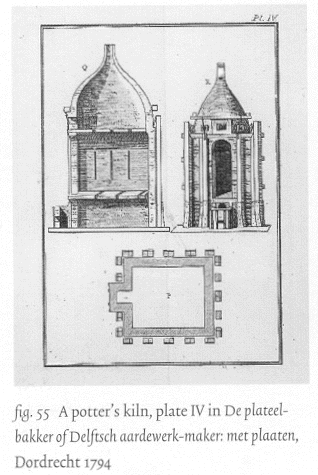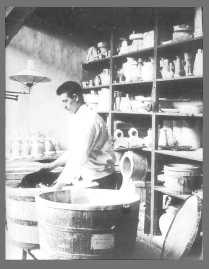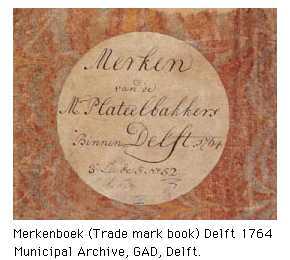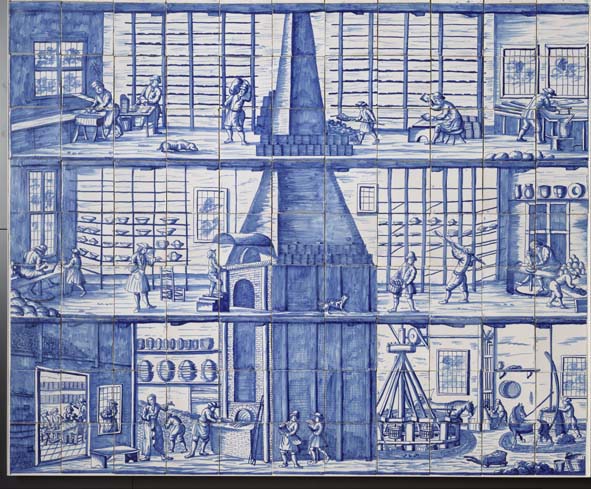 10.
De Gecroonde Theepot (workshop
active from 1692 - 1724), Noordeinde, east side. 'Names
of houses' file mentions this address in 1753.
10.
De Gecroonde Theepot (workshop
active from 1692 - 1724), Noordeinde, east side. 'Names
of houses' file mentions this address in 1753.
(For clickable map of all workshops please go to Delft Blue section which is on view at www.xs4all.nl/~kalden )
All questions about identifying, dating, valuing, buying and selling: please go to www.Aronson.nl.
-->New The Delft St Luke Guild Book is now online.
1. China (workshop active from 1654 - 1743) Nieuwe, Langendijk, north side; exact spot unknown to me. No further detail in the Delft Municipal Archives 'Names of houses' file, which holds thousands of small index cards written in the 19th and 20th century.
2. De Dissel (workshop active from 1640 - 1702) and continued as Theepotbakkerij Jacobus de Caluwe (from 1702-1734). Location was Molslaan, 177-179. Workshop was run by Kruyck and De Cooge.
3. De Drie Klokken (The Three Clocks / Les trois Cloches. Workshop active from 1670 or 1671 - 1841). Located at the very corner of Korte Geer and Korte Breedstraat. The workshop included an area (covered?) at the back yard of this house. Exact address is Korte geer 11a. There was a warehouse, started 1816 at the south corner of Lange Geer 20.
4. De Drie Porceleyne Flessies (workshop active from 1661 - 1777), Gasthuislaan, south side near present day Bastiaanspoort. 'Names of houses' file mentions these in 1692, 1697, 1705. It also mentions the address as Geer, east side. Compare below on this list workshop number 24.
5. Drie Posteleyne Astonne aka Drie Porceleine Astonnen aka Drie Vergulde Astonnekens (- The Porcelain Ashton / Les trois tonneaux de cendre (workshop active from 1655 - 1803 or 1804). Address is Lange Geer 32-36, stretching in the back all the way to Achterom 54-56.
6. De Dubbelde Schenkkan (workshop active from 1660 - 1770), Oude Langendijk, south side. 'Names of houses' file mentions it in 1811 as "Wijk 3, number 414" which is Oude Langendijk number ___ ?.
7. De Eendragt , Unity / Unité (workshop active from 1799 - 1808 and continued from 1808-1830), Also was run under the names of Sanderson / Zonnebeek / Foppe / Valk / Bouvet. Located at Oude Delft 4-10 stretching in the back to Koornmarkt 11-13.
8. 't Fortuyn (workshop active from 1661 - 1784), Fortune / Fortune (workshop active from 1661 - 1784), Lange Geer 22, stretching all the way in the back to Achterom 42-44. 'Names of houses' file pinpoints this house in 1709 as "Geer over 't Magazijn" which may refers to the Oost Indisch Pakhuis (East India Warehouse).
9. Het Gecroond Porceleyn (workshop active from 1645 - 1753), Molslaan, south side. 'Names of houses' file mentions this address in 1706.
 10.
De Gecroonde Theepot (workshop
active from 1692 - 1724), Noordeinde, east side. 'Names
of houses' file mentions this address in 1753.
10.
De Gecroonde Theepot (workshop
active from 1692 - 1724), Noordeinde, east side. 'Names
of houses' file mentions this address in 1753.
11. De Grieksche A (workshop active from 1657 - 1818), Lange Geer 44-46 stretching all the way in the back to Achterom 64.
12. De Ham (workshop active from 1640 - 1726), Achterom, east side. 'Names of houses' file mentions it in 1636 as a brewery and in 1745 as a faience workshop.
13. 't Hart (workshop active from 1678 - 1771), Gasthuislaan, north side between the former Kruisstraat and Brugsestraat. Now: west of Doorniksteeg.This area has been radically changed over the ages. 'Names of houses' file mentions this address in 1698. However, in 1745 the address is given as Zusterlaan, north side.
14. De Hollantse Daalder (workshop active from 1695 - 1721), De Ham, east side [or was it at Kerkstraat / Kerklaan?]. 'Names of houses' file mentions a house of this name in Kerkstraat in 1596 as "Bezijden de NK" (besides the New Church).
15. Het Hooge Huys (workshop active from 1650 - 1741), Oosteinde, east side < Another house with this name is mentioned 'Names of houses' file at Oosteinde, east side in 1739.
16. De Klaauw aka De Porceleyne Klaauw / de Porseleine Klauw (workshop active from 1661 to 1811 or 1840), Gasthuissteeg 9-13 stretching to Breedstraat 18-20. Just east of the Oude Gasthuis church. 'Names of houses' file mentions it in 1744 as at the corner of Gasthuissteeg, which defines it as Koornmarkt number 8.
17. De Lampetkan aka De Porseleine Lampetkan (workshop active from 1609 - 1811), Nieuwe Langendijk, south side / Oosteinde, east side. 'Names of houses' file mentions it in 1739 as the south western corner of Nieuwe Langendijk.
18. De Metaale Pot (workshop active from 1670 - 1775) , Geer, east side. 'Names of houses' file mentions it in 1598. Also listed in 1805 as "Koornmarkt over de Geer" which pinpoints it as Geer number 2 or 4.
19. De Nagtegaal (workshop active from 1633 - 1650), Trompetstraat, north side. 'Names of houses' file mentions it in 1633 as the northeastern corner of Oosterstraat.
 20a.
Het Moriaanshooft (workshop
active from before 1658- 1793), Gasthuislaan, south side.
20a.
Het Moriaanshooft (workshop
active from before 1658- 1793), Gasthuislaan, south side.
20b. Het Oude Moriaanshooft (workshop active from 1690 - 1773), Gasthuislaan, south side. 'Names of houses' file mentions it in 1702 "tot de Vest" (near the fortification).
20c. Het Jonge Moriaanshooft (workshop active from 1690 - 1773), Gasthuislaan, south side. 'Names of houses' file mentions it in 1702 and 1706 as "Bij de Vest" (near the fortification).
21. De Paauw (workshop active from 1651 - 1774), Koornmarkt, west side, about 3 houses from Korte Breedsteeg. And/or Oude Delft, east side, perhaps connected? Mentioned in 'Names of houses' file in 1706 as west side.
22. De Porceleyne Byl (workshop active from 1657 - 1803), Gasthuislaan, south side, near present day Paradijspoort. 'Names of houses' file mentions it in 1690.
23. De Porceleyne Fles (workshop active from 1653 - to the present day. Started at osteinde 171, then expanded with houses next door, west side between Broerhuisstraat and Jan Molslaan. 'Names of houses' file mentions it in 1703 and 1804. Compare above, this list number 4.
24. De Porceleyne Schotel (workshop active from 1598 - 1791), Molslaan, south side, run by Van Goch . 'Names of houses' file mentions it in 1690 as Gekroonde Porseleine Schotel; also lists it in 1704.
25. De Romeyn (workshop active from 1606 - 1774), Achterom, east side. 'Names of houses' file mentions it in 1696 as east side.
26. De Roos (workshop active from 1661 - 1858), Noordeinde, west side, a few houses west of Dirklangensteeg. 'Names of houses' file mentions it a few houses off the corner of Dircklangensteeg (no year).
 27.
Rouaan known after
1715 as Het Lage Huys (workshop active from 1605 - 1742), Oosteinde,
east side. 'Names of houses' file mentions it
cryptically as "5e perceel ten N; NW hoek van het
matrozenslag".
27.
Rouaan known after
1715 as Het Lage Huys (workshop active from 1605 - 1742), Oosteinde,
east side. 'Names of houses' file mentions it
cryptically as "5e perceel ten N; NW hoek van het
matrozenslag".
28. De Twee Scheepjes (workshop active from 1619 - 1794), Molslaan, south side, by the corner of Kruisstraat, run by Keyser. 'Names of houses' file mentions it in 1748 as "vanouds vermaard" (historically famous).
29. De Vergulde Blompot (workshop active from 1616 - 1841), initially at Rietveld, north side and afterwards Molslaan, south side. 'Names of houses' file mentions it in 1671 on the first address and in 1750, 1786, 1804 on the latter address.
30. In de Vergulde Boot (workshop active from 1612 - 1770), Oude Delft 182, stretching to 4 houses in Baljuwsteeg alley. 'Names of houses' file mentions it in 1706.
31. De Vier Romeynse Helden (workshop active from 1581? - 1742), Oosteinde, west side. One of the earliest facience workshops: "betielbacker". 'Names of houses' file mentions it in 1738 and 1741 as a famous workshop: "vanouts vermaerde".
32. De Wildemanspoort aka De Twee Wildemannen (workshop active from 1661 - 1788), Broerhuislaan south side, now Burgwal , south side. 'Names of houses' file mentions it as existing after 1572 (!).
33. De Witte Ster also known aka De Witte Starre (workshop active from 1660 - 1804), Oude Delft, west side, near the Rotterdam Gate. 'Names of houses' file mentions it in 1678 as occupying part of the brewery with the same name, just around the corner of Kethelstraat. In 1725 this place was known as a large hotel and stable; in it lived mr. Walterbos who ran the Rotterdam Ferry.
34.? And a lost sheep: De Kunstenaar.

Note: This list is based upon the following sources:
Van Aken, Delfts Aardewerk , Waanders, Zwolle part 1, 1999 and part 2, 2001. This source provided the "workshop active" year information. It is the best and most complete study to date.
- Exh.Cat. De Stad Delft, Prinsenhof, Delft 1982.
- Ach lieve Tijd XV, 750jaar Delft, de Delftenaren en hun aardewerk , Waanders, Zwolle 1996, p. 352.
This list has also been checked against the
19th century and early 20th century card index in the Delft Archive
on names of houses "Huizen Delft"
More Delft fine art and pottery has been put online on www.gemeentemusea-delft.nl For online archival information on the Delft archive please click www.archief.delft.nl which offers one of the world's most advanced digital archival search systems, made available free of cost. Enjoy!
For more information on Dutch Delftware, you may wish to contact Aronson Antiquairs of Amsterdam | Sinds 1881, an elegant gallery on the Nieuwe Spiegelstraat in Amsterdam, specializing in Dutch Delftware, run by Robert Aronson fifth generation in a traditional family business founded in 1881.
See another web site on Delft blue faience: www.delftsaardewerk.nl
Email me with suggestions (and sources) at kalden@xs4all.nl A full presentation is on view at www.xs4all.nl/~kalden/
Thanks to the Delft Archives Staff for their help and enthusiasm.
Launched January 2002. Last update October 25, 2016.